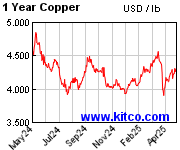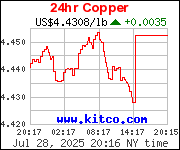
10/18/2010 5:39:30 PM | Matthew B. Smith, theinvestar.com
1637 Reads | 8 Comments
Value lays in its historic mine
This first leg up in the young and vibrant rare earth bull market has given birth to many newfound skeptics on the industry. It is our firm belief that these very skeptics are now laying the very foundation of the proverbial ‘wall of worry’, which we will next stampede over.
At this point, rather than focusing on industry-wide investing, it is our opinion that company specific events will provide the most upside, thus starting now we will begin to shed light on the most exciting and lucrative opportunities in the sector.
We have constantly stated we believe investors can use the most recent uranium bull market as a blueprint for where the rare earth bull market will take us. To further that idea, we believe that the rare earth mining industry will mirror in development to that of the uranium market only a few years back. Aside from Mountain Pass, as it stands now, we do not see anyone else actually getting into full production before 2015 in North America. In Africa we see the possibility of at least two mines getting into production before then with potentially another in Europe. Australia will have two, and Asia we think could have three.
Low cost Asia should be a cornerstone of anyone wanting to invest in near-term production not currently being fairly valued by Bay Street or Wall Street. We believe that someone will rise out of Asia much like UrAsia did during the uranium boom. Investors worried about its properties due to perceived geopolitical risks, however due to the fact it quickly got into production with low cost assets, it quickly became a billion-dollar entity.
From our extensive research, we are of the opinion that Stans Energy Corp. (TSX: V.RUU, Stock Forum) provides one of the most intriguing investing opportunities for investors. The company could have the past producing open pit Russian rare earth mine, Kutessay II, located in Kyrgyzstan, up and running in late 2012. Their mine produced REEs for the former Soviet Union with half of production being the truly valuable heavy rare earth elements (HREEs).
The company has begun some exploration efforts to further understand this extraordinary project. They will test the depth of the mineralization at the mine as the Russians never tested more than 25 meters below the bottom exploration drift, even though the deposit is widening to depth. According to Robert Mackay, CEO of Stans Energy Corp., this was due to the fact that, “they had 72 years of mine life when they started the mine based on 300,000 tons a year.” Mr. Mackay also indicated that the Kyrgyz Ministry of Resources has issued a 25-year mining license associated with the mine and it is fully permitted to re-start operations. The mine is currently the only HREE mine outside of China fully permitted for operations, thus putting the company years ahead of many of their competitors.
Stans Energy is on friendly terms with the government in Kyrgystan and has, “had nothing but positive experiences when dealing with the Kyrgyz government,” according to Mr. Mackay. The country wants new mines, foreign investment and jobs for its citizens. Also of significance the country recently held elections, which we have been informed went smoothly.
The company is testing a new zone 500 metres southwest of Kutessay II, and we believe they will find further rare earth mineralization similar to that found at the old mine. We believe that the project may contain further zones (much like the one the company has drilled) to increase resources. Investors will know for sure about further areas of exploration interest later this year as the company will be undertaking a complete geophysical survey over the 40 sq. km area of the Aktuyz Ore Field in the fall.
The exploration is certainly an exciting part of this project, however we think the real value in Stans Energy lies in the historic mine. Most of the buildings are there, along with a mill and according to Mr. Mackay, “the equipment used at KCMP is still used today in the industry and it is all titanium and stainless steel so it was overbuilt like many Soviet plants.” The company also has the metallurgical process the Soviets used to extract the rare earths, which they will use as a building block to increase their extraction rates via new technology and chemicals.
Stans Energy should also be releasing a JORC resource estimate for the Kutessay II open pit mine, which should be one of the most detailed resource estimates most investors will see in their life. Samples were gathered from the mine wall as well as from underground access points that go the length of the mineralization. Stans will know exactly what REEs are where in the mine along with detailed ore grades. When the Russians discovered this deposit, they determined it had 72 years of mine life at 300,000 tons a year. The deposit was mined for 30 years, so close to 2/3 of the deposit is left for Stans. The historical tonnage on the project was 51,500,000 kgs of REOs.
It is our opinion that the company reaches production in 2013, due to their in-place infrastructure and permits as well as location. Mr. Mackay says that the, “best case scenario would be production in late 2012,” so we are confident with our number. Further, this puts Stans Energy on track to be one of the first HREE mines to production. We believe that Stans will be one of the few REE players to reach the production threshold, and one of the first to deliver significant quantities of REEs while prices are still high for the LREEs and the easy supply contracts for HREEs are available, thus at current levels the stock is underpriced. Over the next six months shares in Stans Energy could easily approach C$1.00 per share as the story gets out regarding their near-term production profile.
We believe that the stock is poised to move significantly higher in the short-term due to the company generating significant news flow. The company should be releasing the JORC resource estimate soon, has the potential to add further deposits to the project through exploratory drilling on the seven domes they know are there due to the Russians and any further areas they may discover, and has all of the necessary licenses to get the mine up and running. Due to the tremendous groundwork the current management team has done, Stans Energy could be one of the biggest winners in this young rare earth bull market.
Disclaimer: Mr. Smith does hold a small position in Stans Energy at this time
--------------------------------------
http://www.stansenergy.com/















